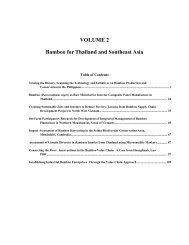WBC-VIII-Vol.4 – Resources – Forestry, Plantations and ... - BambuSC
WBC-VIII-Vol.4 – Resources – Forestry, Plantations and ... - BambuSC
WBC-VIII-Vol.4 – Resources – Forestry, Plantations and ... - BambuSC
You also want an ePaper? Increase the reach of your titles
YUMPU automatically turns print PDFs into web optimized ePapers that Google loves.
soil surface is usually started to mulching during the period from November or December to March of next year<br />
to increase soil temperature <strong>and</strong> keep soil moisture in the winter season. The data showed the ground<br />
temperature could raise 4-5 after mulched with organic materials (Fang et al. 1994). During the mulching<br />
process, rice straw was firstly mulched to a height of 10-15 cm from the surface <strong>and</strong> then rice bran was filled<br />
onto another height of 10-15 cm. The total rice straw <strong>and</strong> bran used in one time commonly reached 40 <strong>and</strong> 55 t<br />
hm -2 . In the next year, the undecomposed rice bran layer was removed in March or April while the rice straw<br />
almost decomposed or mixed into soils. In the next mulching time, the removed rice bran was mixed with new<br />
to be used. The fertilizer applications were used for three times, i.e. mid-May, mid-September <strong>and</strong> the time<br />
before the mulching, respectively. The fertilizer application rate was about 2.25 t hm -2 (N:P:K=16:16:16) <strong>and</strong><br />
urea 1.125 t hm -2 , sometimes manures with equal nutrient used as well. The use of organic material mulching<br />
technique began from the 5th year after the bamboo transplanting.<br />
Soil Sampling<br />
During the bamboo plot selecting, similar soil position, l<strong>and</strong>form, initial soil fertility <strong>and</strong> soil basic<br />
physiochemical properties before bamboo plantation were considered. The selected planting time was 1 5 10<br />
<strong>and</strong> 15 years, respectively. After 10 years, the bamboo st<strong>and</strong> became to showing degradation in the field. The<br />
rice field was chosen as the control because the bamboo planted on soils shifted from the paddy soils. Each<br />
replicate of plot selecting was located at one farmer’s field to keep the same original condition of soils from the<br />
influence of field management. The area of each selected bamboo plot is larger than 100 m 2 . Due to the shallow<br />
root depth of Lei bamboo, the soil profile was separated into 5 layers as 0-5, 5-10, 10-15, 15-20 <strong>and</strong> 20-25 cm,<br />
respectively. Before the collection, litters <strong>and</strong> mulching materials on the soil surface were removed. We selected<br />
three sites for sampling <strong>and</strong> there replicates were done on the each bamboo plot <strong>and</strong> paddy plot. Fresh soil<br />
samples were air-dried <strong>and</strong> ground to pass through 2 mm sieve. In order to test the hypothesis of Al toxicity with<br />
low pH to Lei bamboo, roots of bamboo were also collected in each plot.<br />
Soil Analysis<br />
Soil basic physicochemical properties, including soil pH, organic matter, nitrogen, cation exchangeable capacity<br />
(CEC), were analyzed. Soil pH was determined by electrode method. Soil organic matter was measured with<br />
K2Cr2O7 oxidation <strong>and</strong> FeSO4 titration. CEC was extracted by 1 M NH4Cl <strong>and</strong> K, Na, Ca <strong>and</strong> Mg were<br />
determined by the atom adsorption system (AAs). Because Al may be one factor influencing bamboo growth in<br />
red soil with low soil pH, various Al forms were also measured. These Al forms included exchangeable Al,<br />
dissociated Al, amorphous Al, organic bound Al <strong>and</strong> total Al. The exchangeable Al was extracted by 0.1M KCl<br />
(James et al. 1983), dissociated Al (Ald, dithionate), amorphous Al (Alo, oxalate) <strong>and</strong> organic bound Al (Alp,<br />
pyrophosphate) were determined by the method proposed (Odes 1963; McMeague <strong>and</strong> Day 1966). Bamboo<br />
roots were digested with HClO4+HF <strong>and</strong> Al content was measured by AAs.<br />
<strong>VIII</strong> World Bamboo Congress Proceedings Vol 4-59




